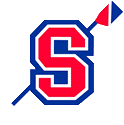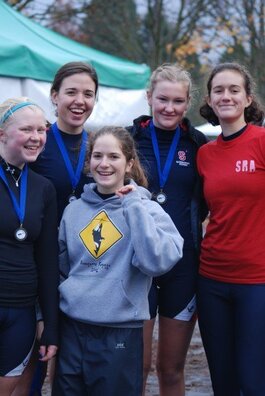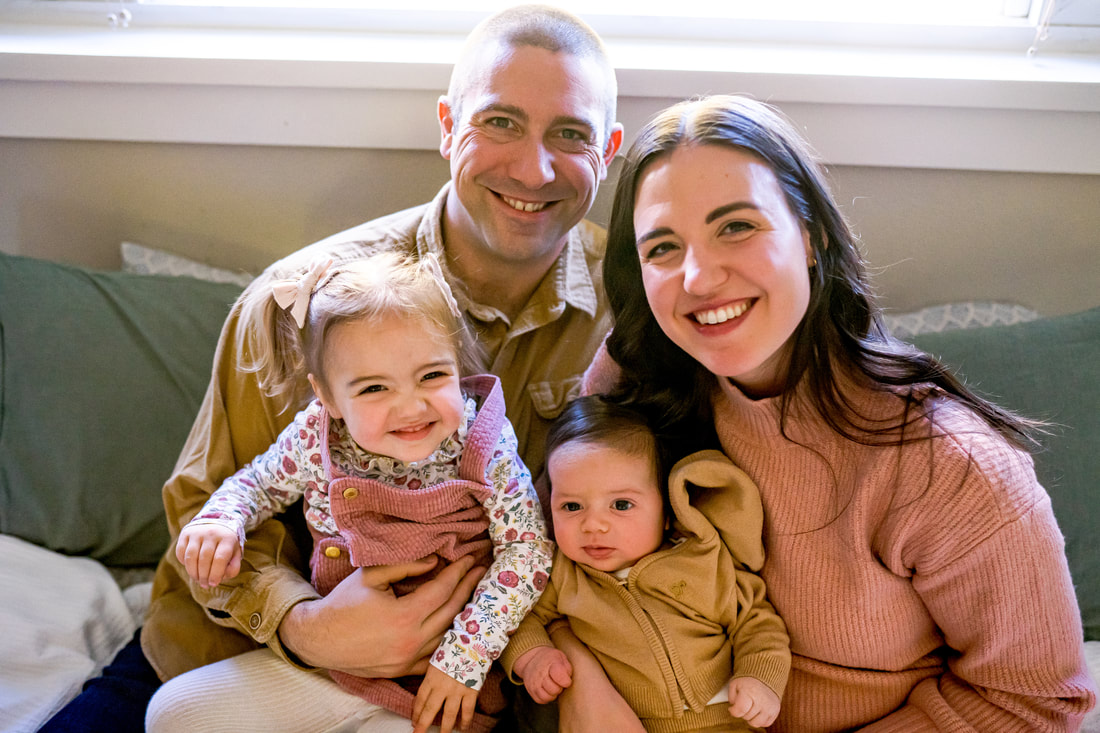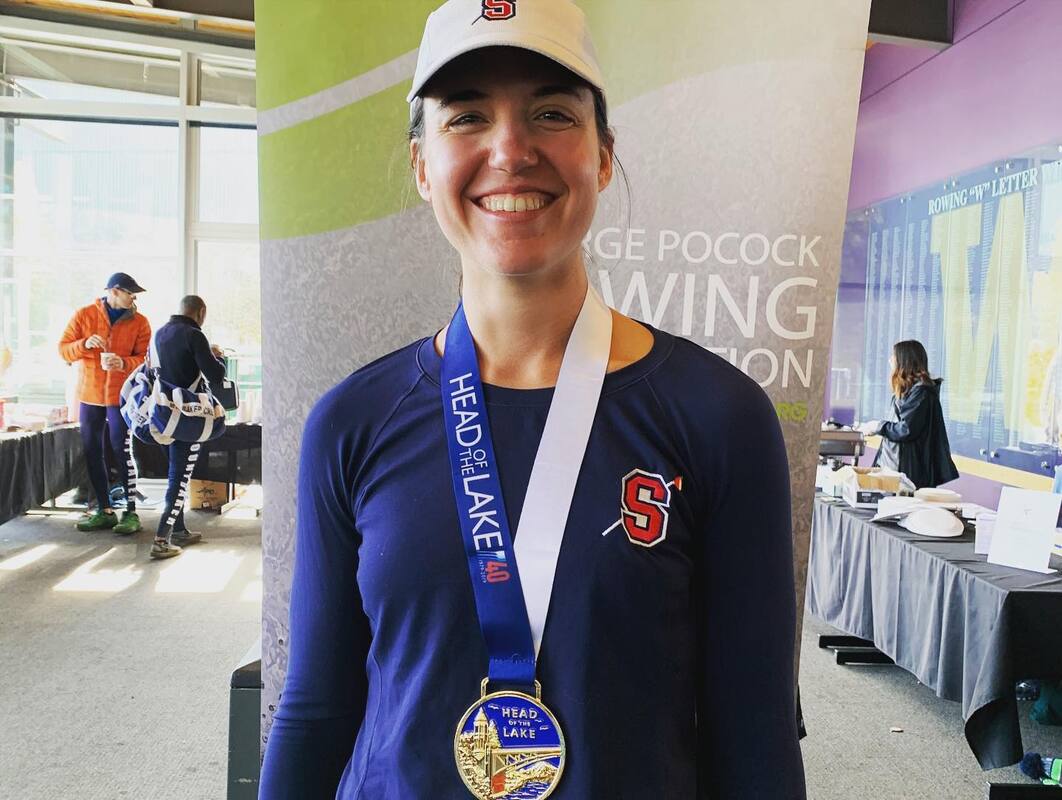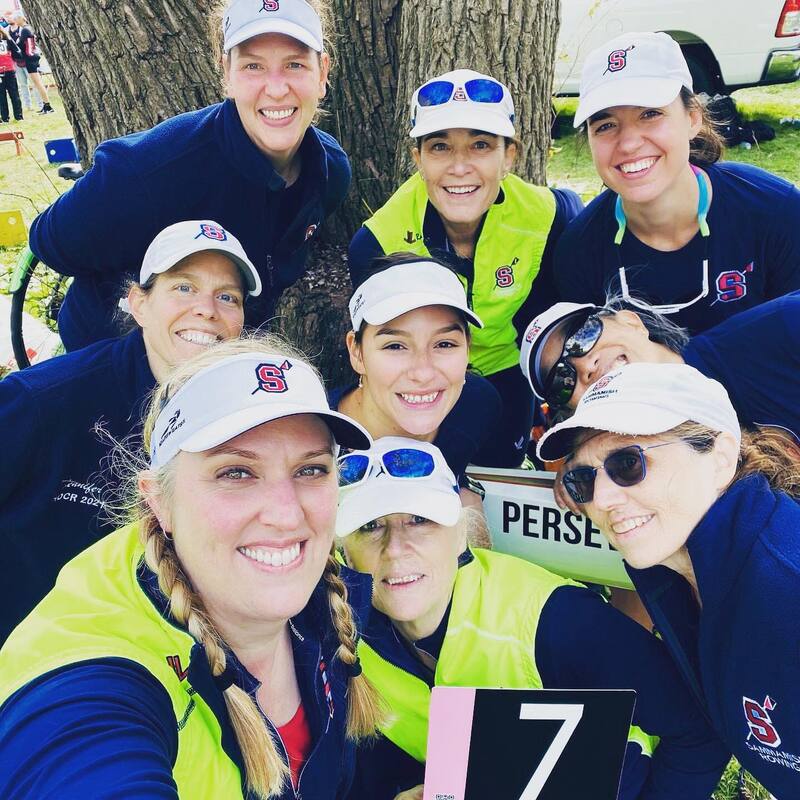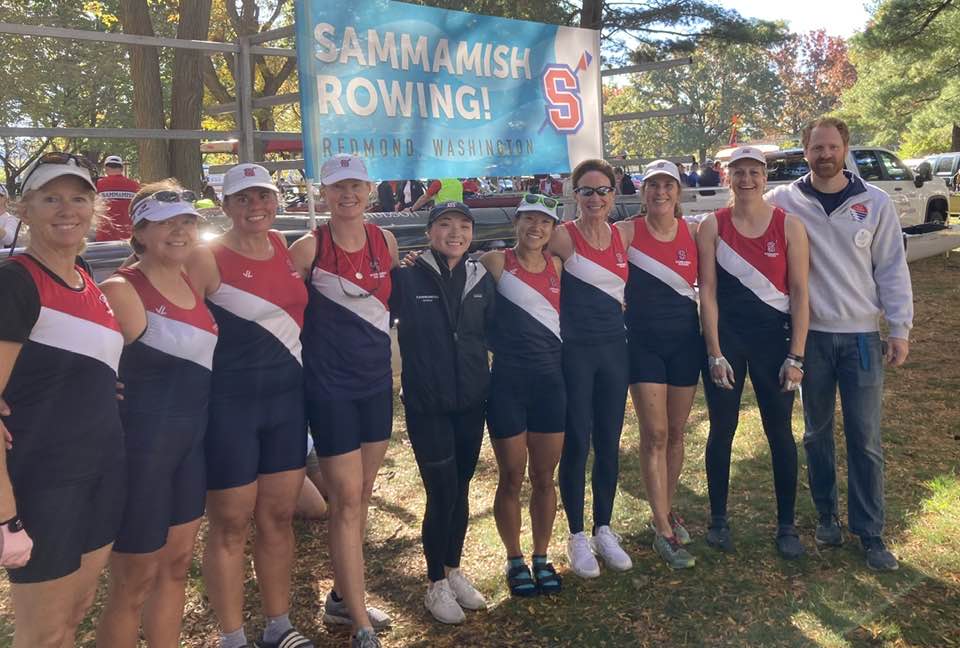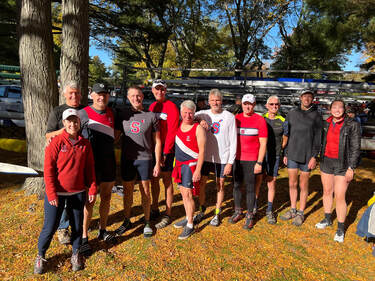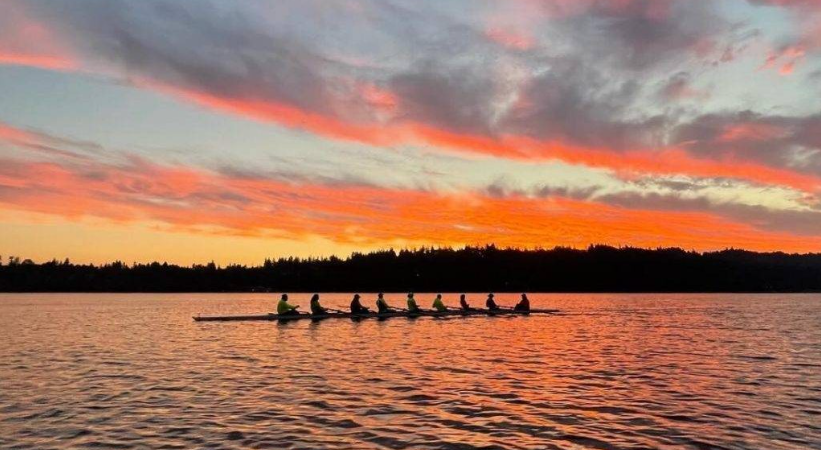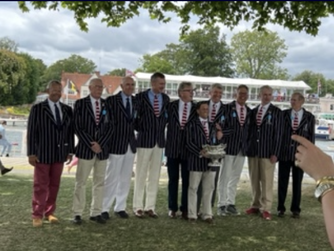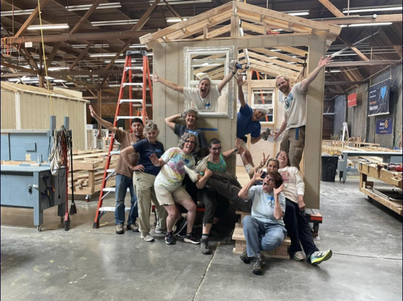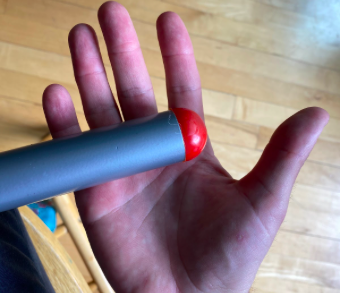|
Many rowers are familiar with the struggle of finding balance between all the things they want to do and need to do in life. For our junior rowers, balancing practice with school, homework, family time, hanging out with friends, tutoring, and other activities teaches them how to manage their time really quickly. Additionally, our adult rowers need to manage even more with work, childcare, vacations, chores, appointments, friends, family, and other hobbies as well. Sammamish Rowing Association has a strong desire to expand the sport to young adults. Statistically, most of our master rowers who have children either have children currently in high school or who have moved out as young adults. This has left very little representation for young parents on our masters teams, but one 5am rower is absolutely crushing it as a young mom.
She credits discipline and preparation as keys to balancing her early morning rows, taking care of her kids, and working her full time job. “The key is being disciplined about being prepped and ready for the next day and getting to bed early. Plus, when you have kids, they go to bed early and I’m not too far behind them! I couldn’t do it without the support of my husband, Jeff, and our family that is close by,” she added. The boathouse was basically a shack when Postlewait began rowing in 2006. Portable bathrooms were outside and rowers changed behind sheets strung up on the ceiling. Weight training was completed with concrete filled paint cans. Nevertheless, incredible coaching by her coach at the time, Courtney Moeller, and the amazing friendships she made and memories shared at the Hod Fowler Boathouse solidified rowing as a passion for Postlewait. After a gap in her rowing career, she met up with an old friend, Dennis Ferrer, and got the scoop on masters rowing. In 2019, she joined the 5am team and the rest is history!
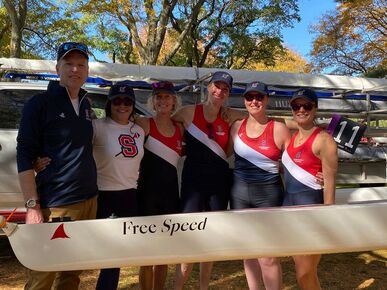 Since the inception of The Head of the Charles Regatta in 1965, the event has attracted hundreds of thousands of rowers to Boston and the Charles River. SRA has had the opportunity to attend this regatta for years and to compete against top crews. This year, all our competing crews qualified for entires in 2023. HOCR was back up to full capacity with top crews from across the country as well as numerous international crews. Rowers were lucky to have some of the best weather ever for this year’s races. SRA's top finish was a silver medal for the 5AM’s women’s 40+ 4+. They overcame multiple challenges to bring home SRA’s first medal since 2019. Coach Kenzie Waltar of the 5am team competed with her dad, Steve Waltar, in the Directors Challenge Parent/Child 2x category. Waltar said, "It was an honor to race the Head of the Charles with my dad. The two of us have been training together for a couple of months and to have it pay off with some fun on the Charles was such a gift! We passed a few boats, we were cheered on by many UW and SRA friends, and we competed with heart. I'm so glad we got to do something so special! SRA, thank you for making this possible. It's something we'll never forget!" In addition to current SRA rowers, we were fortunate enough to see several alumni from our junior program competing this past weekend. Brooke Caragher (U Penn), Grace Sappington (Cornell), Lucy Climer-Kennedy (Northeastern), and Jacob Zelenko (San Diego), all recent SRA Junior Program alumni, were spotted competing this year and we could not be more proud to see them continuing their rowing careers on such a renowned stage. All of our crews did an outstanding job and deserve recognition as well. Below, board member Dale Quigg has compiled our team results along with video links. Please join us in celebrating our incredible rowers, coaches, and coxswains for their amazing performances at The Head of the Charles Regatta! 2022 Head of the Charles Overview for Sammamish Rowing Association Friday, October 21, 2022 W GMV 1X Women's Grand Master/Veteran Singles [50+, 60+] Ann Creighton Results Top 25% Finish Video: Cambridge Saturday, October 22, 2022 M SM 8+ Men's Senior Master Eights [50+] C: Jessica Pare 8: Sohier Hall 7: Tyler Simpson 6: William Senenko 5: Brett Barton 4: Mike Fitzner 3: Kirby Meyer 2: Marc McGinnis 1: Patrick Eames Results: Top 50% Finish Video: Reunion Village Cambridge W SM 8+ Women's Senior Master Eights [50+] C: Lisa Caldwell 8: Ann Taylor 7: Karen Tollefson 6: Maxine Lee 5: Susannah Pryal 4: Jeana Vasey 3: Arminda Phillips 2: Sue Bailey 1: Paula Sandige Results: Top 50% Finish Video: Reunion Village Cambridge M GM 4+ Men's Grand Master Fours [60+] C: Jamie Moseley 4: Kevin Hansen 3: Scott Winter 2: Charles Turner 1: Scott Merritt Results Video: Reunion Village n/a Cambridge W SM 4+ Women's Senior Master Fours [50+] C: Madison Goertz 4: Tanya Wahl 3: Trisha Miller 2: Jennifer Martin 1: Nancy Johnston Results: Top 25% Finish Video: Reunion Village Cambridge W MSTR 4+ Women's Master Fours [40+] C: Genevieve Carrillo 4: Jennifer Teschke 3: Christen Kartaltepe 2: Rebecca Rowe 1: Yulia Poltorak Results: Silver Medal Video: Reunion Village Cambridge n/a W MSTR 4+ Women's Master Fours [40+] C: Amy Shotwell 4: Celine Suzzarini 3: Beverley Ashton 2: Summer Taylor 1: Susan Cameron Results: Top 50% Finish Video: Reunion Village Cambridge n/a Sunday, October 23, 2022 DC PC 2X Directors' Challenge Parent/Child Doubles 2: Stephen Waltar 1: Kenzie Waltar Results Video: Riverside Reunion Village Cambridge Thank you to Sammamish Independent for this incredible feature of our organization! It's no secret that SRA provides a welcoming experience for new and returning rowers. At SRA we invite everyone to discover a passion for rowing, explore personal potential, and celebrate team success! Read the article here: https://sammamishindependent.com/2022/10/a-local-rowing-club-welcomes-anyone-willing-to-learn/?fbclid=IwAR3ini60ghXLkwHoVs82QyGfBXvbiwlK7WGVTg2NPtaHObJGXLfGF11_cZM 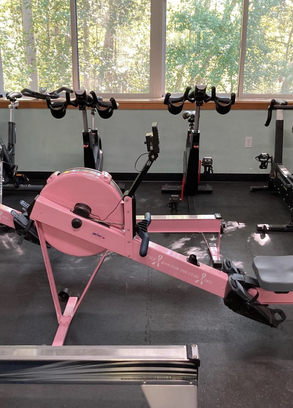 Nearly everyone is affected by breast cancer in some way. Maybe a co-worker, a friend, or family member has had to fight against it. Maybe you yourself have been diagnosed. Millions of people are affected by this disease and millions more are joining in the fight against it through awareness, fundraising, and general support. Sammamish Rowing Association has had members diagnosed with this disease so this fight is a personal one. In recent years we have had incredible members who have gotten our club more involved in the local Seattle Row for the Cure event. This event is a regatta and fundraiser committed to raising awareness and funds for breast cancer screenings, research, and support. Over the years we've sent countless rowers to participate in the regatta, and we've gotten more serious about fundraising. With about a week until the regatta this September, SRA had passed the $10,000 fundraising mark, hitting out initial goal and earning a pink erg for our erg room. Mid-Morning rower, Birgit Bertram, had set up SRA's overall fundraising page and members could create their own sub-pages to solicit donations from friends, family, and colleagues. As we surpassed the $10,000 mark, the RFTC team came to us with a new goal. If we raised $20,000, we could have two pink ergs! We accepted their challenge and in the end we raised a total of $23,728! This was an incredible show of support in the fight against breast cancer and it was truly a team effort. Our top fundraiser was junior rower, Andreas Giakoumakis, who raised $4,002. Andreas began rowing in 6th grade and currently rows with the Experienced Junior Boys Team. He loves his friends and coaches who make SRA an amazing place to be. When asked why he decided to fundraise for RFTC, Andreas said, "My mom, who is a two-time breast cancer survivor, mainly inspired me to raise money for RFTC, and at first I didn’t think I would raise more than 500 dollars, but everyone exceeded my expectations. I think it is important to raise money for breast cancer research so it can be detected early, and less people and families can be affected." "I love how my mom is very understanding and kind," he added. We have to admit, we appreciate how kind and understanding Andreas is and our staff members are so proud of his hard work and dedication to the cause. To everyone who helped us reach this milestone, and for all those committed to the cause of defeating breast cancer- thank you for your incredible support this year. Get ready to break more records in 2023! 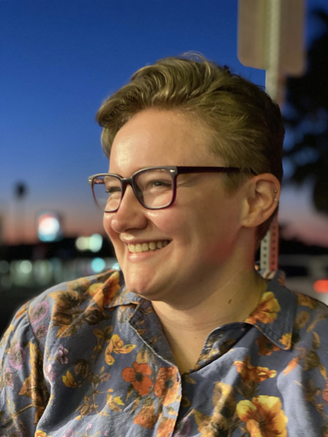 This month, SRA added a familiar face to our full-time staff. Many rowers from our junior and masters teams will remember learning the basics of rowing with Sydney Colburn. Sydney spent many summers coaching our middle school programs, Row for a Day classes, and Learn to Row sessions. Sydney has a wealth of knowledge for building a strong rowing foundation for rowers and has supported several SRA teams. Sydney joined SRA in the spring of 2014 looking for a new activity outside of soccer and karate. After checking out SRA because a friend rowed, Sydney instantly fell in love with the sport, eventually graduating from the junior rowing program. “My favorite memory at SRA is my first year on the experienced high school team. I was in the 3V (our lowest boat at the time), but we were completely undefeated over the course of the season. It was such a fun boat and I still think about those races and how much fun they were.” Sydney recently graduated from the University of California, San Diego with a Bachelor of Arts, double majoring in Linguistics and History, with a minor in American Sign Language. During their time at UC San Diego, Sydney also rowed for four years with the Women's Rowing team. When asked what they love about the sport and what they’re looking forward to with SRA, Sydney said, "I love everything about rowing. I love how much effort you have to put into the sport. I love how unique and specialized it is. I love being out on the water early in the morning when everything is calm and you can hear the birds. I love the sounds of the slides and the oarlocks and the blade slipping out of the water. I love how close a group of people gets when preparing to race together, and how rowing requires the entire boat to work as one – it's the ultimate team sport. Now, as a coach, I love teaching the sport and watching people fall in love with rowing just like I did." We couldn’t agree more! Sydney joins as our Learn to Row Coordinator and as an assistant coach for our junior girls and masters teams. Having worked with many first-time rowers, they offered some advice. "My best piece of advice for a new rower would be to have patience – in themselves, their teammates, and their coaches. Rowing is a very difficult sport and it takes a long time to get good at it, so don't expect to figure everything out right away." Join us in welcoming Sydney back to our community! We look forward to many wonderful rowing sessions on the lake and the joy of rowers falling in love with the sport thanks to Sydney’s guidance.
The Henley Royal Regatta dates back almost 200 years, and they firmly hold to tradition. High on the list of British social events, formal attire is required to enter the Stewards Enclosure viewing area. Racing is a single elimination match on a course slightly longer than 2 kilometers.
Woodman’s boat was sidelined from Olympic competition when the U.S. and other countries boycotted the 1980 Olympics in Moscow. Tom notes that his crew is often remembered for what they weren't able to do. However, his team defines their legacy with their ample accomplishments. Evidence of their success is visible at the National Team Training Center in Princeton; CRI in Boston; Newport Aquatic Center in California; Sammamish Rowing Association; and even facilities in New Zealand and Australia. Tom shares the reunion was a success and a time to celebrate. After the Henley, a couple of Woodman's boat mates traveled to Lucerne, Switzerland where they also raced in 1980. The Rotsee course there is the best rowing course in the world, and they were able to watch World Rowing Cup III on a beautiful summer weekend before heading their separate ways. When asked what problems the Greater Seattle area faces, what comes to mind? For some, the issue of homelessness will pop up. Knowing that many of our fellow citizens are without housing is distressing, and one SRA member wanted to do something about it. Aimee Woolwine of the Masters Mid-Morning Team decided to make a positive change by giving back to the community. After running across Sound Foundations NW on social media, Aimee began volunteering at The Hope Factory, their building facility in SODO. The goal of Sound Foundations NW is to end homelessness in Seattle and share what they learn to communities with the same intent. "Getting folks out of unsafe living conditions and into a safe place of their own changes their lives. Every person is worthy of that feeling of peace and safety. These homes and the villages they are placed in are a highly effective conduit to a healthier life for so many people," says Woolwine. Working with other SFNW volunteers on a weekly basis, she saw volunteering as a great experience to share with her teammates.
A huge congratulations and thank you to Aimee and the Mid-Morning team for an amazing feat and doing great work for our local communities. Interested in getting involved? Reach out to SRA staff to connect with Aimee or click the link below to see how you can improve people's lives by providing homes!
By Coach Liza Dickson This is a companion article to the video. If you haven't watched the video, check it out below: A common question I get regarding technique revolves around layback - how much should a rower have? I think my rowers want a simple answer to this, but as usual with me, there isn’t a simple answer. For this discussion, I’m going to explain a bit about how I coach and my style. Every coach has their own style - there is room for all of them, your coach has one and you should listen to it. But never be afraid to ask them “why?” they coach anything the way that they do.
The style of rowing that I coach is based upon the optimal utilization of both a rowers body and the equipment. Basically, trying to use those two things the way they were intended on being used and in tandem. Focusing on these two things prevents injury and promotes optimal boat speed. Each rower is different, so my style revolves around trying to find the optimum use of their body. That’s why if you watch my crews row down the Montlake Cut on Opening Day, they are not perfectly matched with the bodies. Unfortunately, in Junior Rowing I have not had the luxury of a matched set of 8 rowers that were all 6’5! Instead of making them all look the same (when their bodies seldom are the same), I work on helping each athlete attain their most effective and efficient stroke based on the biomechanics of their body first and foremost. That is step 1. Oversimplifying an entire year of coaching, the next step is looking at oars: catch angles, and stroke lengths making sure they are matched (and yes, sometimes that means making the short guy row with extra layback - but only if he is capable of it physically). None of the above works if you are not set up properly in relation to the equipment, but here again we border on the different rowing styles, so I’m going to leave it to your coaches to set you up the way they want you in the boat. Now that you have some understanding on my approach, on to that pesky layback question. Of course all rowers want to be as long as possible, but there are limitations with their body (individual anatomy) and the setup of the equipment (physics). For each athlete to find the layback that is appropriate to them, I have my rowers row feet out. It’s important to make sure you are on the seat properly on the front of the ischial tuberosities (bottom of the pelvis, aka sit bones). Once feet are out, I am asking our athletes to find the layback that THEIR core can support with the feet out of the shoes. So on the drive, athletes are pressing into the feet and as the blade comes out of the water, the pressure on the bottom of the feet must cease. Rowers are in the layback position and without their feet in the shoe, they can not rely on the top of the shoe to hold them in the layback position. Rowers MUST rely on the strength of their core. It takes some strokes each day with feet out to find that perfect layback where the rower is relying on their core strength to end the drive and make the turn to the recovery learning NOT to rely on the tops of their feet. When rowers pull excessively on the top of the shoes in the layback position they are not in control of their body - the body is able to FALL to the bow. That is not optimal for boat speed. Additionally, pulling excessively on the top of the shoes means you don’t have to use your core. If you go back further than the strength of your core will allow, you are putting your back at risk. A few things go into this core strength and it goes beyond doing a core workout every day. (though you still do need to do that work!) The next thing is physical development. For instance, a teen boy is still growing rapidly and while we can strengthen the core muscles, the connections through ligaments and tendons remain loose within the whole body. Therefore, they are likely not going to be capable of a longer layback solely because they are still growing. Often my junior boats do not have very much layback for this reason. As that rower enters his early 20’s his core will be capable of a longer layback. Take a look at a college crew and you’ll see that. The final thing is length of time rowing. So many times you hear your coaches say things like : “ you just need to take more rowing strokes to be good at this!” This is true for developing your core strength - the longer you row, the stronger those muscles get from rowing and the more efficient you are, therefore making you capable of having some longer layback. As my sculling coach always said, “The best core workout for rowing is using your core while rowing!” I’ll pick up on that topic next time. Feel free to reach out with any questions at [email protected]. I spent one year intensively studying anatomy, physiology and biomechanics in massage therapy school. That knowledge changed how I coached. The outboard hand has two main functions: leverage and control. On the drive, the outboard hand is the most direct part of your body that applies power to the oar. Around the release and on the recovery, the outboard hand gives you the best control over the path of the handle (and blade), and the height of the blade over the water. That means we’re asking a lot of our outboard hand: within a single stroke they have to be powerful and aggressive, but also delicate, dexterous, and careful. That’s quite the task! In this article, we’ll break down the role of the outboard hand through the back half of the stroke, from arm draw, to extraction, to the beginning of the recovery. Applying Downward Pressure The first thing to recognize about the outboard hand is how it contributes to the height of the blade. A squared blade naturally wants to sit at about the right height for the drive (almost entirely submerged underwater). Let the equipment do most of the work for you: think of this squared and buried position as the default resting place for the blade. You don’t have to do anything to keep it in this position. That means you don’t need to do anything to keep the blade in position on the drive. Focus all your energy on the horizontal application of power--the vertical component will take care of itself! When you want to control the height of the blade, keep it simple: all you need to do is apply downward pressure on the handle. You can do this with just one finger if you wanted to. Next time you’re in a boat, try this: sit squared and buried at the release. Take your hands off the oar except for your outboard index finger. Push down on that finger gently and lightly: the oar extracts cleanly and easily out of the water. Now relax the downward pressure: the oar returns to the water. And this took very little effort to accomplish. This is what it means when coaches talk about “weighting” and “unweighting” the hands. Anytime the height of the blade changes (i.e. at the catch and at the release) this is the economy of movement you want to strive for. Hand Position at the Release What should the outboard hand look like around the release as you extract the blade by applying downward pressure? Well, here’s a few pictures (this metal bar was the closest I could find to an oar handle in my house). 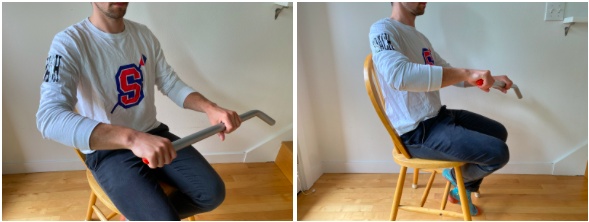 The final arm draw. In this photo I am finishing the arm draw of the drive. The (theoretical) blade is still fully buried, and I’m squeezing in towards the sternum. Note the outboard wrist is flat. At this point, the outboard hand is focused mainly on a powerful, horizontal draw. There’s not much finessing required at this point. 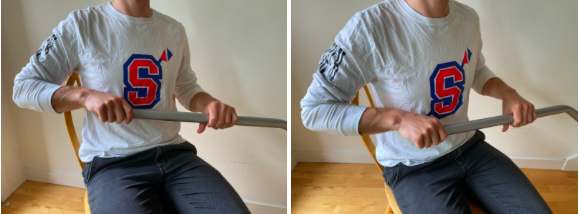 The very end of the drive. The elbow is away slightly from the body, but not a mile high into the air; it has also not gone past the body. The wrist is still flat, not cocked up. There is a slight lateral twist from the wrist, and the end of the oar has swiveled ever so slightly in my hand. Note that the blade is still in the water, and I am just about to begin the extraction. This is when the power winds down and the finesse takes over. 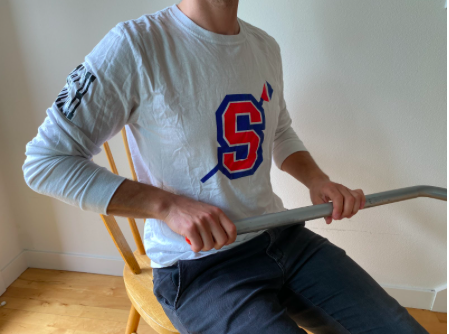 The extraction. This part of the stroke should be all about precision and finesse--the drive is over, so you shouldn’t be doing any yanking with that outboard hand. This is where you want to think about “weighting” the outboard hand to apply vertical, downward pressure. It doesn’t take very much force. Properly timed, this will slip the blade out of the water cleanly and easily. At this point, the inboard hand does the feathering (but that’s a topic for another article). Make sure the outboard wrist doesn’t bend here--you want to stay ON TOP of the handle, and let the handle just rotate underneath your hand as the feathering happens. You want your grip to be just enough to maintain control, but not so much that the handle can’t rotate in your hand. The Recovery The crucial responsibility for the outboard hand on the recovery is just maintaining a level height of the blade above the water. You do this by maintaining just the right amount of downward pressure on the blade, like we previously discussed. 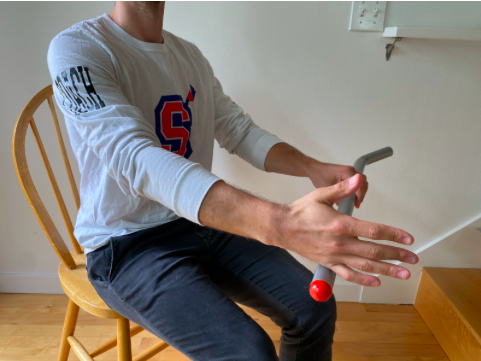 Try this! The karate chop recovery: instead of the usual outboard hand grip, replace it with a karate chop. You can’t lift the oar, or even really hold it in place. It limits you to think about your downward pressure only. All you are doing is counteracting gravity, which wants to drop the blade into the water. As you take the recovery, look out at the blade, and make sure the height of the blade stays consistent above the water. Notice how an inconsistent application of downward pressure means you can’t hold the blade level on the recovery. Conclusion
The outboard hand is a crucial connector between the equipment and the rest of your body. Don’t overthink and don’t overpower it (on the recovery at least!). There’s a time for really powering, and there’s a time for finesse--knowing when to balance these tasks is a crucial skill for getting the most out of the outboard hang. Below is a autobiographical/historical piece I had written up to share with 5am about some of the places I have rowed around the world, and some of the people I have met through rowing. It also contains a couple videos to row along with. Most of the 5am team have their erg set up with these videos running as they do their Monday workouts, mostly at 3/4 pressure range. Tom Woodman First, I have a movie I want you to watch. “Kiss the Joy” is about Joan Lind who is an icon in American rowing. See below for the link to the movie. It ties in with the story that follows:
We were given this link below with encouragement to donate to the her Endowment Fund at the National Rowing Foundation. Let me add that the NRF is legit and the group that supports our national teams. They funded our 1978 effort that we will be following next week (as well as all the other years) so I encourage you to contribute something if you are able to. They have some special challenges this year with the one year delay in the Olympics. "For anyone wanting to contribute to US Rowing and Joan's endowment, just go to: https://natrowing.org/kiss-the-joy/ It'll help some very special people... Regardless - at the end of the day, this film is about the joy of sport and life- and an extraordinary human being. Let me know if you have any problems with the link below- and don't hesitate to send feedback. Enjoy! Take care out there during this very difficult time... Best, Jean" https://vimeo.com/260889888 PASSWORD: JOAN-1976 Oregon State University, 1978After suffering a back injury my Sophomore year, I had walked away from rowing at Connecticut College. My Junior year I transferred out to Oregon State University and the following year, in the fall of 1976 with the encouragement of some rowers I had come to know, decided to join the rowing team. I had looked into it the previous year at OSU but the rowing coach had talked me out of it. In the fall of 1976, Robert Zagunis (just back from racing at the 1976 Olympics in the 4+) coached us. He is the person who inspired me to pursue the level of rowing I did and is a close friend to this day. (He also must have inspired his daughter Mariel Zagunis- she became the first American ever to win a gold medal in fencing and is a 4 time Olympian (2004/2008/2012/2016). Actually she recently had made the 2020 team also. She was the flag bearer for the US team at the 2012 games.) OSU rows on the Willamette River. It is the fastest moving body of water I have ever rowed on, and the higher the water gets in the winter, the faster it moves. Typically the team would come off the water for December and January due to the high water level and amount of debris/logs coming down the river. The video you will row along with shows what it looks like now. Back in the 70’s the boats were kept in a set of WWII barges that floated on the water at either end of the dock you will see. However, there were a couple boats kept in a Quonset hut up by the “barn”. Since I had science labs many afternoons, I was often relegated to the losers who would come to practice late and have to row in one of the “Spirit 4+s”. These boats had been made at OSU during the depression out of about 1/2” plywood. The 4+ easily weighed more than our 8+'s do today, and were about 6’ wider than an 8+ is in the middle. Needless to say it was a workout just getting it into the water, and it didn’t move along very fast. One thing to keep in mind if you ever row in Corvallis is to turn around about 1/3 the way through the practice, because it will take you much longer to come back upstream than it did going downstream! My final year I only had two terms left to complete my coursework. So, as any good rower would do, I decided to work fall term, and then go to school (row) winter and the spring racing term. General rowing goals for the year: #1 compete in the spring racing season at OSU #2 Try out for the national team that summer. (I had thought about it the previous year, but had to work instead.) Beginning of January. Big Problem. I come down with a really bad case of Mono. I laid on the floor for about a month, lost a bunch of weight, and couldn’t go to class. I was so weak that I had to crawl to the bathroom and sit on the toilet because I couldn’t stand up. I was worried about being able to pull off the term and graduate. February. Finally I started to get better. Faster. I gained a pound a day for 3 weeks. My poor roommates appealed me to kick in some extra money to cover the food bill because I was consuming so much. I obliged. I recovered fully and was ready to race by the first race in mid-March. Our first row that day, will be here on the Willamette River in Corvallis. The video below is shot in August when the river is really low and slow. Check out how long and steep the ramp is that they carry the boat down to get to the dock (3:30 in video). Two years ago the water was so high in the winter that it was over the bank and a couple feet deep in the parking lot. Workout Video #1
Philadelphia, 1978After the regular season at OSU my final year there, four of us skipped graduation and went east to race a 4- in the IRA (which was held in Syracuse back then on a huge lake that could have all sorts of wind issues. Years later they finally abandoned this site for holding IRA’s). Winning there helped me make the next step- trying to make the National Team. The Worlds were in New Zealand that year, and not until November (rather than the normal early September timeframe), so there was a lot of club rowing that summer, with National Team selection later than usual, in late summer. I decided to move to Philadelphia to row with Ted Nash who was the U Penn coach. He had rowed for Lake Washington Rowing Club back in their golden years, racing in the ’60 and ’64 Olympics (Gold and Bronze), and eventually went to 11 Olympics as either coach or athlete. Ted was unbelievably driven, resourceful and quite a character. We would always be hearing stories about him, and say “no way, that is true”, but later find out it was. Lots of stories there. I was lucky to land there because Ted put together the best collection of oarsmen in the country that summer and it was a deep/talented group: Chatzky, Otto Stekl, Sean Colgan (and more- from Penn), Ibbetson (UCI and stroke of ’77 US 8+), Hull (Dartmouth), Townsley (and his pet skunk- from Syracuse), Turner (UCLA), Prelou (UC Berkley), a couple from Wisco, UCSD, and many more. A bunch of us lived in a frat house on the Penn campus, paying a dollar a day for a place to sleep. It was a pit. All the dishes from the school year were left unwashed in the kitchen, and never were washed that whole summer. Hardest however was the oppressive heat. I was sharing a room with another guy and I was lucky enough to get a fan that I could point directly on my body, uncovered and wearing just underwear, to sleep. Still I would wake up in the mornings wet from sweat. However, I was thankful I didn’t have the worst room. The guys on the top floor described how on the hottest days, the tar dripped through from the tar roof above melting and seeping through. Or the following year, the two guys who slept in a closet. It was so small that they had to shut the door (which opened inward) to lay down. It was not a pleasant smell in the mornings. I got a lucky break at one point that summer when Anita DeFrantz let me stay at her place while she was out of town for an extended time. It was a nice break, in a quiet neighborhood and the house was much cooler. I had met Anita when we were both rowing back in Connecticut my freshman year. She was a senior, and went to Vesper that summer to row. (I ended up helping to drive their Vesper boats out to Women’s Nationals that June- in Lake Merritt CA, where we rowed for Masters Nationals 2 years ago). Anita went to law school at U Penn, and continued on a successful rowing career. She was in the 8+ in the 1976 Olympics that got the bronze rowing with Harry Parker. In 1980 Anita lead the charge to fight the boycott. She put her skills to work filing a law suit against Carter to try to allow the US team to go. Although the suit was unsuccessful, her efforts caught the attention of many, and a few years later she was elected to the IOC (International Olympic Committee) where she ended up eventually as Vice President and served until recently. I had a bike which I rode to the boathouse. At one point in the summer I was forced to take a big detour for several days. The slum I had to ride through turned out to be where the MOVE headquarters were. They had had a big shootout with the police that week. This was also the summer that the garbage collectors went on strike. So, the garbage just got piled in the middle of the streets. At one point black garbage bags were piled almost one story high, running 100’ down the middle of the blocks in the neighborhoods I rode through. Filthydelphia became the chosen word for the city. During this timeframe there was a big revolution occurring in boat construction and design. Pocock had been the dominant US manufacturer up until the early 70s. They made their boats out of all wood, and the riggers were pretty well fixed with no adjustments possible. In the Penn boathouse and in many others on the east coast the Pococks were being replaced, mostly by Schoenbroad boats. They had riggers that you could make all sorts of adjustments to, and had fiberglass hulls with a wooden interior framework. While the fiberglass was pretty maintenance free, the wood had the same old issues the wood boats had. The varnish got worn off and the wood would start rotting if not refinished. And the framework could break and loosen up over time. This loosening up was the main reason boats only lasted 10 years max back then. If you got in a 10 year old wood boat rigged traditionally, the stroke seat would be down to port all the time, while up in the bow, the boat would be down to starboard all the time. This twisting of the boat was due to the weight of the end oars on the riggers on the recovery over time. Pococks were especially susceptible to this because Pocock built his boats loose/flexible on purpose. And his oars were soft/super flexible too. Stan Pocock stuck with that philosophy through the 70’s and 80s as the market moved away from him, with people looking for stiffer boats and stiffer oars, and as other manufacturers transitioned quickly to synthetic materials. Ted Nash gave me a job that summer so I could earn money to eat. My job was to help the boatman by sanding down the interior wood structure of U Penn’s boats (mostly Schoenbroads), glueing broken pieces, and varnishing the wood). I remember working on their dock slip for endless hours that summer, sanding away, and looking out over the city. On most days you could see about a mile or two, and that was it. I'm not sure if it was humidity, smog, or most likely both, but it was striking how short the visibility was most days. In 1978, as now, one of the best brands in the world were Empachers, made in (West) Germany. That’s what we always raced in at the Worlds, and they were really sweet boats-and all glass/carbon, even in 1978. In these International videos you watch, the light yellow boats are generally Empachers. (The East Germans made their own boats that only East Germans rowed. They had a distinctive look with a much deeper hull, right from the bow of the boat.) Our next virtual row will be a row where we trained, on the Schuykill River. “Boathouse Row” is worth checking out if you ever get to Philadelphia. There are 15 boathouses in a row, all built 100-150 years ago, just above a dam on the river. The boat you will row with is launching from close to the downstream end of Boathouse Row, by the dam (which is next to the Art Museum where Rocky ran up the steps in the movie). So, you will get to see the whole row of boathouses from the water. Note that at 65 seconds in, just a couple strokes off the dock, you will pass the cable device strung across the river. (It was erected prior to when I rowed there so that if you flipped near the dock you have a chance to grab onto it and save yourself (they had lost a gal who flipped and went over the dam before this was installed). The U Penn boathouse that I rowed out of has a bunch of red on the top face of it that you can see as you go by. It is right next to the famous Vesper boathouse (where Jack Kelley Jr. and Sr. rowed and the 1964 Gold Medal Olympic 8 was assembled). Along the shore on this stretch that we will row is Fairmount Park and Kelley Drive (named after Jack Kelley- Google that name, both Jr and Sr.) on one side. The Schuykill Expressway is on the other side. (A couple of the guys worked on a crew replacing guardrails there during the day. It was nicknamed the SureKilll Expressway). Workout Video #2
At 14:30 into the video you go under Columbia Bridge with a slight turn. It is hard to see but right after that bridge on the shore are some grand stands. This is the finish line for the 2k course that is used for races like the Dad Vail, Independence Day. It is the only 2k course I have rowed on that has a curve in the middle of it. Take a break at the top of the island when they turn around, 17:30 into the video. (This is about 500 to go on the race course. The Head of the Schuykill starts further up river). Leave the video running, but get off the machine and stretch for 3 minutes but hop back on and pick it up with them as they go under the Columbia Bridge again at 20:30 into the video, and follow it back to the boathouse. For about the last 2 minutes, the rate and pressure come up together, so build with it, finishing at full pressure @30 SPM. Paddle it back to the dock, stop video at 33 minutes, and go on to the next video.
One of the memories I have most firmly burned into my brain are the endless pieces we did racing our 2+ (Otto/me/Chatzky) against the 2- of Ibbetson/Colgan. Ted was really good at handicapping the boats. We would start first in the 2+, and then Ted would start the 2- after a calculated pause so that, I think every single piece, the 2- would finally catch up and go through us in the last 10 strokes to the Finish Line of this race course you rowed by in the video above. This is where I learned to handicap races and what I try to replicate on our Race Day Fridays. It’s Ted’s fault, so you can blame him! Ted did an unbelievable job of lining up a summer full of races (I am not sure how it was all financed, but the fact we all rowed in U Penn shirts, and I am listed as a U Penn graduate in some of the records may be a clue):
Selection started in Princeton, where they have a buoyed course for seat racing. Later it moved to Dartmouth, NH. Dartmouth was a wonderful place to row. I loved it here. Swimming off the dock after practice, cooler weather with less humidity, and in beautiful northern NH - out of the Filthydelphia urban setting that I disliked so much. (We will row here when I cover 1979 next week.) Because the Worlds were in NZ in 1978, the expense of sending a team was much higher and so the US had decided to take a much smaller team than usual- just a 4+, 2- and 2+. I was trying for the 4+ at this camp. After a long brutal selection process, the boat was announced and I made it! (Vreugdenhill, Otto Stekl, Lubsen, me and cox Jaugstetter). Immediately Vrugedenhill revealed that he had a job teaching in Philadelphia he was committed to, so we had to change plans for the next month+ of training. So we left Dartmouth and went back to Philadelphia to train for the next stretch. That was disappointing, but a patron of US Rowing let us stay in his air-conditioned condo in Philadelphia and we thought we were in heaven. Well, at least as close as you can get to it in Philadelphia. In October we moved to Long Beach CA, trained there for a short stretch and had a scrimmage with the Canadians. Long Beach rows in the LB Marine Stadium, a manmade course constructed for the 1932 Olympics. They had a bunch of old wooden Pococks that we used. If you go back in time far enough, boats used to have much shorter tracks. I am guessing they changed this in the 60’s? These older boats’ short tracks took some getting used to because you would hit the stern stops before you had compressed to your usual spot. I also remember using these old boats because in our scrimmage with the Canadians, we were ahead of them with about 500 to go when the wheel on the seat of the guy in front of me completely disintegrated and I got to watch him attempt to keep rowing (no slide) while the Canadians went by us. Another memory was of doing a long row one day. We left the protected canals there, went out into the Pacific and rowed to the Queen Mary and back.There was just a small gentle roll so it was ok. On that row Chatzky, the cox of the bow loaded 2+, hit a buoy (it was broad daylight, so maybe he fell asleep?). We still give him grief about it to this day. Pete Gardner (Dartmouth coach) was our coach this year. He was a good person, we liked him, but it was concerning how he would start off every morning after practice with a couple beers by the hotel pool. Earnie Arlet was coaching the scullers. He was the guy who had the idea that became the HOCR. Long Beach is where Joan Lind trained- so if you watched the movie I recommended, “Kiss the Joy”, then you have been there! (Joan was on most the teams I was on, including this1978 trip to NZ.). In case you didn’t catch it, back then the women only raced 1k while the men raced 2k. We raced on different days at big regattas so they could make the changes to the starting platforms for the different distances. In 1978, unlike other years, we stayed with the women’s team most of this trip and it was fun to get to know most of them. Next stop for us was Australia for a couple weeks of training in Sydney, and some racing. We trained out of the Sydney Rowing Club. Typical of clubs over there, they had slot machines and bar upstairs (to help finance the club) and the shells were downstairs. We slept in a different boathouse across the bay. We had a couple launches at our disposal to get back and forth. We put the launches to use. I remember some of the guys playing frisbee in the boats, and occasionally making a diving catch into the water. We heard later there were sharks in Sidney harbor. Another day we went to a beach outside of the city and I saw for the first time the shark fences they had to keep sharks out of the swimming area. The launches had a quirky behavior and had a V shaped hull. I remember driving one by myself at full speed, sitting on the right side behind the steering wheel and throttle. Suddenly without warning the launch tipped to my side, putting the gunwale, half my body and part of the steering wheel and throttle in the water- at full speed. It was all I could do to stay in the boat and stop the launch! After that I tried to sit in the middle of the launch and reach over to steer the boat. At the end of our stay, we raced on the Napean River in Penrith, outside of Sydney. Since then, they have built a beautiful manmade course (for the 2000 Olympics) next to the river. So it sounds like everyone rows there now rather than on the river. The thing I remember most about that place were the flies. I have never seen so many. You had to continually wave your hand around your face, etc or it would soon be covered with flies. No good videos here, so we are heading to NZ now. Lake Karapiro, New Zealand, 1978It is now late October and Halloween was celebrated (one of the guys dismantled the toilet in the hotel so he could be that for the costume party). 1978 was the first time the Worlds were held in NZ. It was beautiful and very rural. There are more sheep than people there. However, there were some real challenges. One was getting enough high quality boats there to race in. The guys in the 2+ were to row a boat from NZ. When they got there, they found out it was heavy and had a SitUp cox, rather than a LayDown cox. I had never seen a sit up 2+. Finally a lay down boat was found on the South Island that they were able get and to race in. Our 4+ was shipped in a container from USA. However, the container was about 4’ shorter than the boat. So our boatman Conn Findlay, cut off the bow, and then when he got to New Zealand, glued it back on. (Conn Findlay is another interesting person- google him if you want. He was in the 1956(Gold), 1960 (Bronze), and 1964 Olympics (Gold), all in the 2+. Then, he switched to sailing and won a Bronze in 1976!) In 1978 the facilities at the course were small and primitive. The buildings were all new but thrown up quickly, without insulation or sheetrock. That was no problem back then, but when they held the World Championships again here in 2010 (the video we will row along with) it looked much different. To see what it looks like now row along here: Workout Video #3
I was happy with our results (4th) that year, the top placing by a US men’s boat. After the races a bunch of us crammed into a van and toured around the North Island for about 4 days before heading home. It was a blast. By then it was mid November so I headed back to Corvallis Oregon, worked on a Christmas Tree farm harvesting trees, and tried to figure out how to approach the next year’s racing.
|
Archives
April 2023
Categories
|
|
Sammamish Rowing Association
5022 W. Lake Sammamish Pkwy NE Redmond, WA 98052 [email protected] 425-653-2583 |
Mailing Address:
Sammamish Rowing Association P.O. Box 3309 Redmond, WA 98073 |
|
